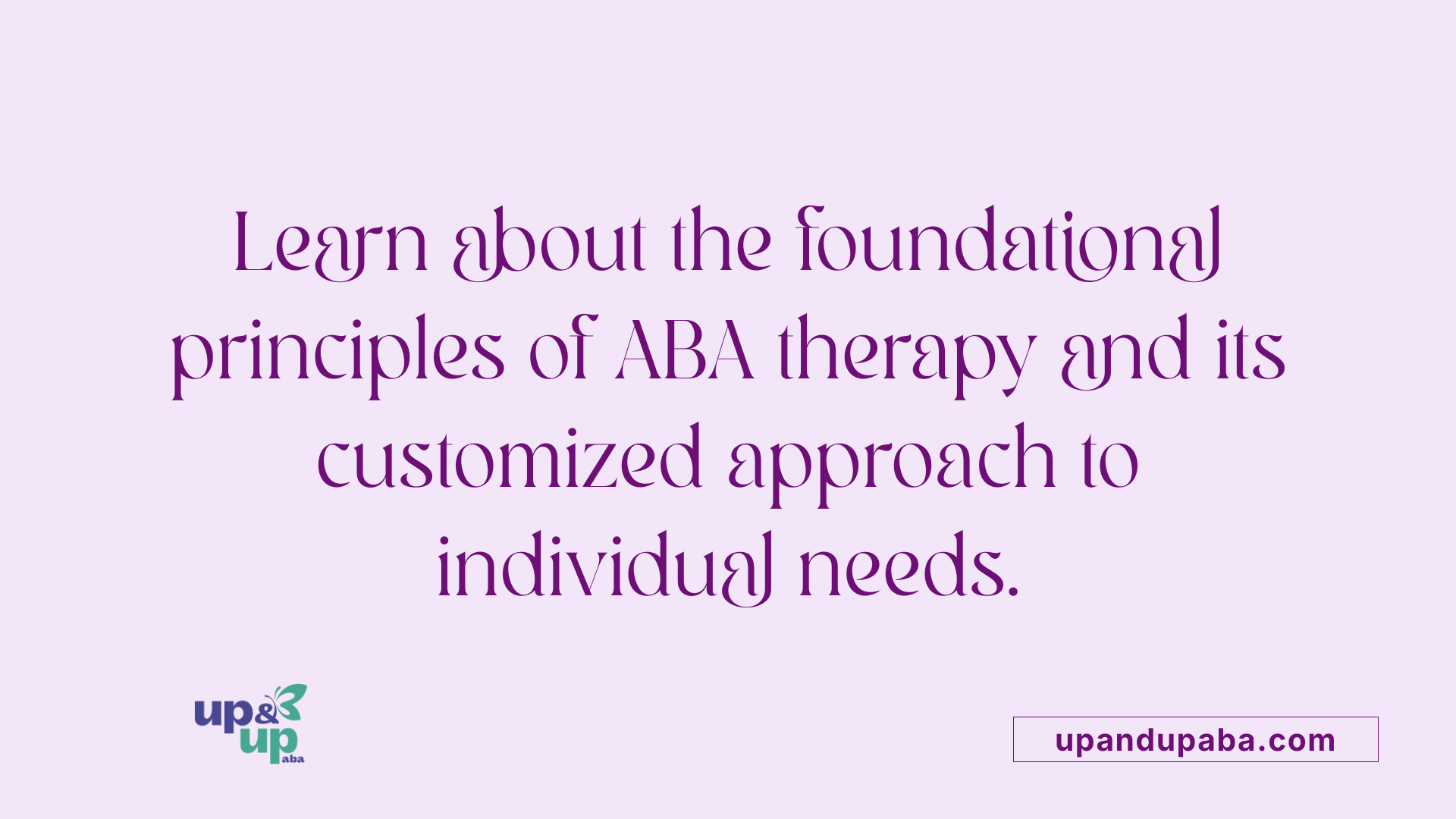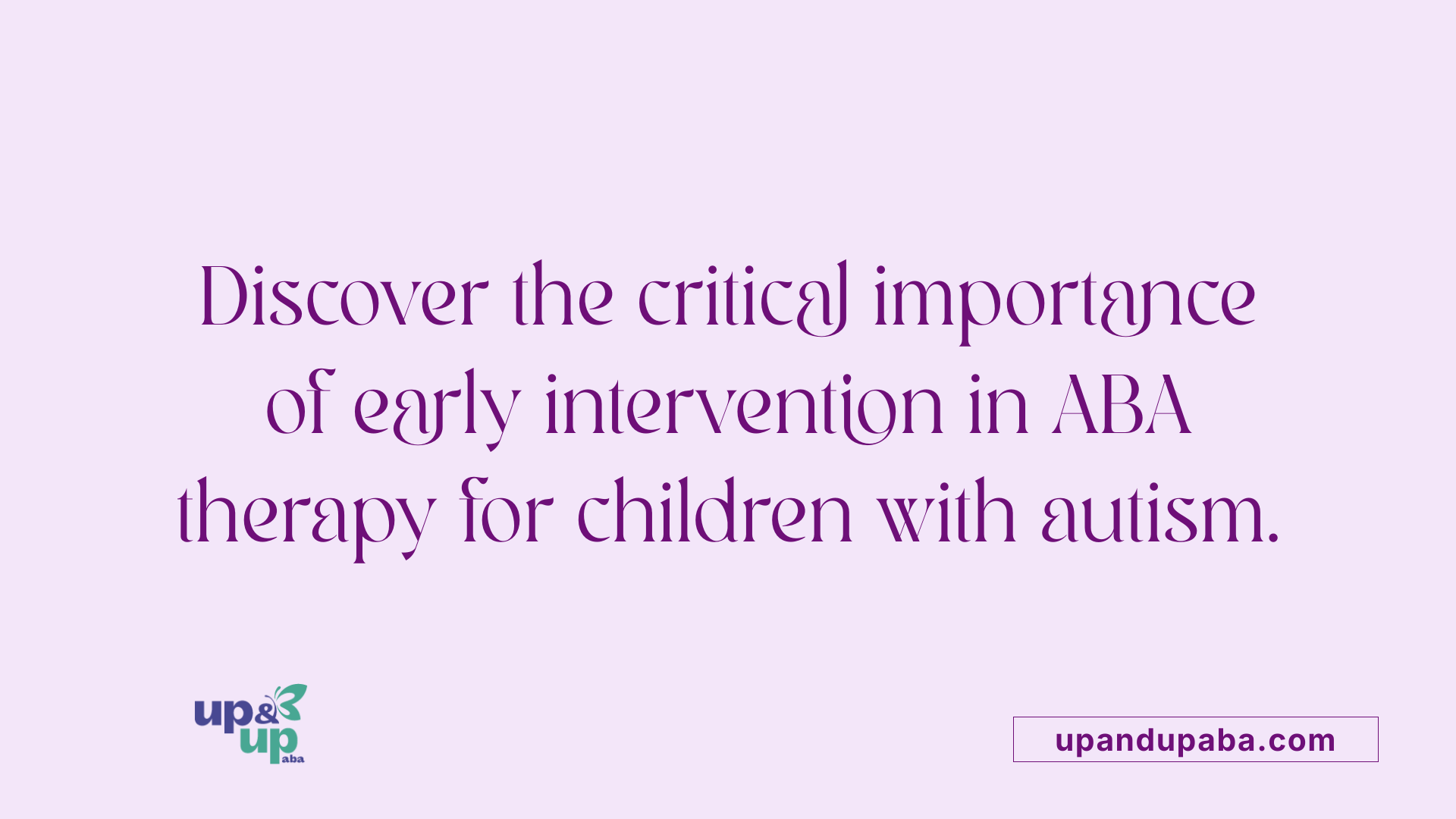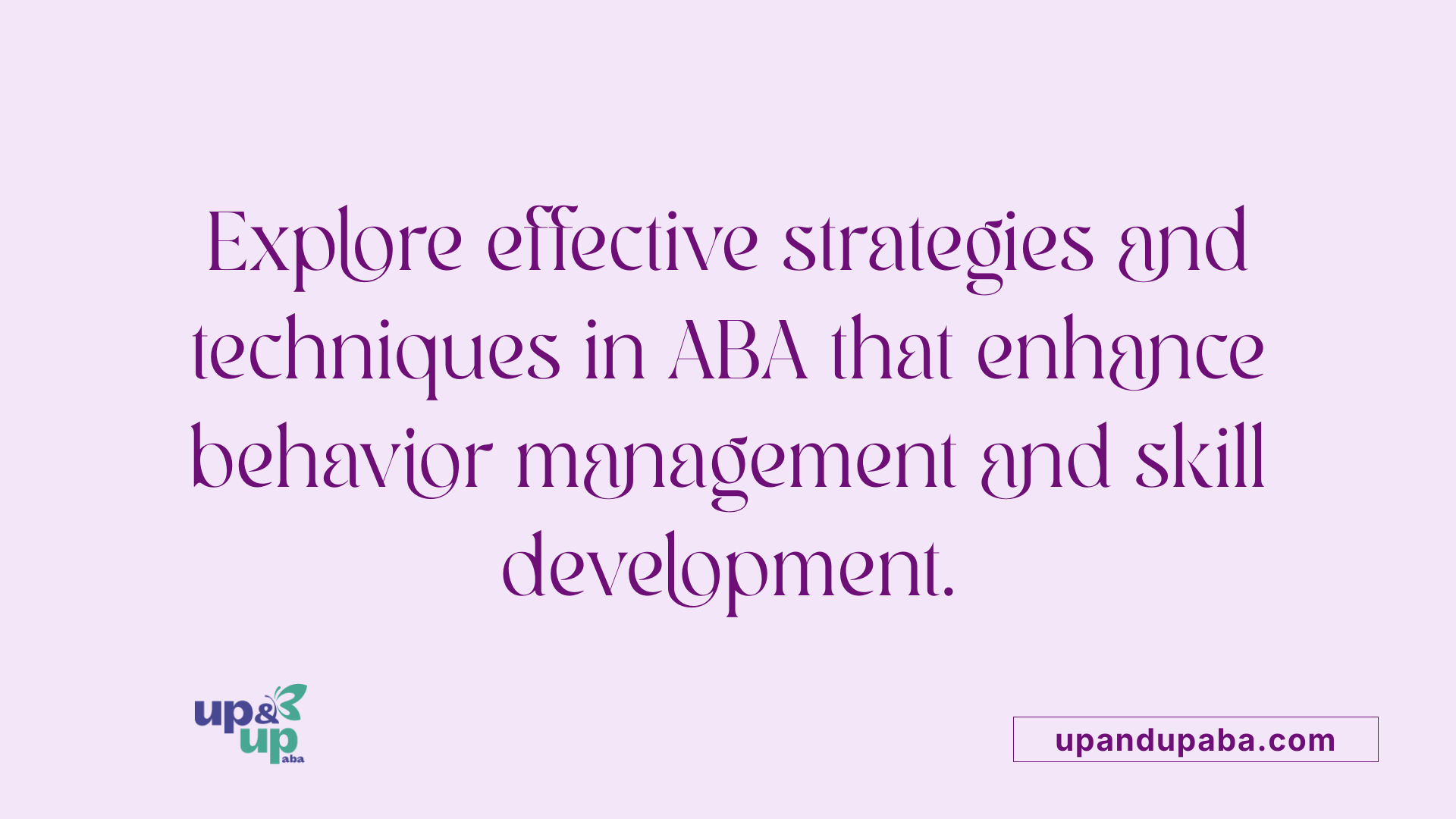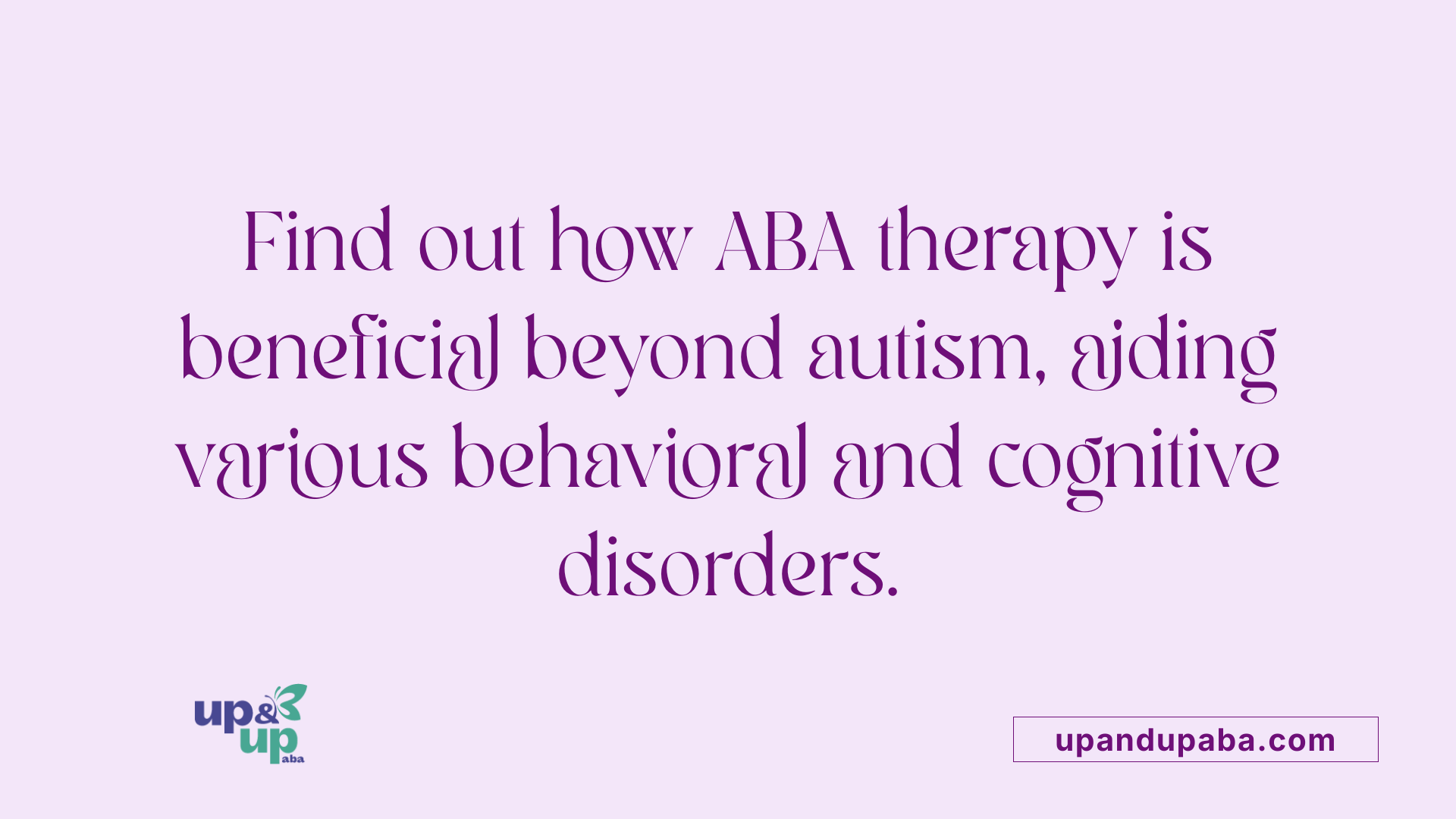ABA Therapy for Child Behavioral Support Programs
Unveiling the Potential of ABA Therapy in Child Development

Introduction
Applied Behavior Analysis (ABA) therapy stands out in the realm of child behavioral support, particularly for those with autism. It utilizes scientifically-based methods to enhance various skills by reinforcing positive actions. This article delves into the key aspects of ABA therapy, exploring its methodologies, effectiveness, and potential benefits for children.
Understanding ABA Therapy

What is ABA therapy?
Applied Behavior Analysis (ABA) is a research-based therapy that focuses on improving behaviors and skills in individuals with autism and other developmental disorders. It employs techniques rooted in learning theory, primarily using positive reinforcement to encourage desirable behaviors and reduce challenging ones.
Each ABA program is customized to meet the unique needs of the individual, often created by a Board Certified Behavior Analyst (BCBA). ABA therapy can be conducted in various settings, such as homes and schools, tailoring interventions to enhance effectiveness for each child. Research has shown that intensive ABA therapy, particularly when delivered in early childhood, can lead to significant improvements in communication, social skills, and day-to-day functioning.
Techniques used in ABA therapy
ABA employs a variety of techniques to support skill development and behavior improvement, including:
- Discrete Trial Training (DTT): Skills are taught in small, structured steps.
- Pivotal Response Training (PRT): Focuses on pivotal areas of a child’s development to encourage broad improvements.
- Functional Behavior Assessment (FBA): Identifies behaviors and their functions to inform targeted interventions.
The mixture of methods ensures a holistic approach to learning, allowing for the flexibility to adapt as the child's needs evolve.
Customization of therapy programs
Customization is crucial in ABA therapy, as each child presents unique challenges. Individualized treatment plans take into account personal strengths, challenges, and growth areas. These plans are created based on comprehensive assessments and ongoing adjustments according to the child's progress.
Families play an essential role in this process, ensuring consistency between therapy and home environments, which contributes to a more effective learning experience.
Early Intervention and Optimal Age for ABA

At what age is ABA therapy most effective for children with autism?
The optimal age for receiving ABA therapy is during the early developmental years, ideally before the age of four. Most children begin treatment between the ages of 2 and 6, which is a critical window for intervention. Studies have indicated significant benefits from early therapy, and these positive outcomes can often be maintained for up to 18 years.
The Early Start Denver Model (ESDM) stands out as a program specifically designed for younger children, starting as early as 6 to 15 months old. This model emphasizes the involvement of parents in the therapeutic process. While early intervention is essential, it's important to note that ABA therapy can remain effective for individuals of all ages, catering to specific needs and developmental goals.
Importance of early intervention
Early intervention through ABA therapy can set the foundation for long-term academic and social success. Research demonstrates that children who receive early therapeutic support often show improved language skills, social interactions, and emotional regulation. These early interventions help children to build essential skills that are crucial for effective learning and personal development.
Long-term benefits of early ABA
The benefits of starting ABA therapy early are substantial and can include improved communication and social skills, better academic performance, and increased independence. When the therapy is tailored to individual needs and provided consistently, particularly in the ages of 2-7, children can experience transformative changes that positively impact their daily lives. The commitment to a minimum of 15 hours of ABA support per week is essential for achieving these lasting benefits.
Harnessing ABA for Behavioral Improvements

Effectiveness of ABA in Managing Behavior
Applied Behavior Analysis (ABA) is designed to effectively assist children facing behavior challenges. The therapy is based on solid research regarding learning and behavior, elucidating how environmental factors influence actions. By focusing on increasing constructive behaviors and diminishing detrimental ones, ABA helps improve essential skills like communication, social interactions, and academics.
Recognized as an evidence-based best practice by the US Surgeon General and the American Psychological Association, ABA therapy is especially effective for children with autism. Studies have shown that early intervention maximizes its benefits, particularly when initiated between the ages of 2 and 6. This makes ABA a pivotal component in managing behavior, aiming to create a supportive learning environment.
Techniques and Strategies for Behavior Change
ABA employs a variety of techniques to facilitate behavior change. Some of the most notable methods include:
- Positive Reinforcement: This core strategy rewards desirable behaviors, increasing their likelihood of reoccurrence.
- Discrete Trial Training (DTT): Breaks skills down into smaller, manageable parts, allowing focused learning and mastery.
- Functional Behavior Assessment (FBA): Identifies behaviors and their underlying causes to tailor interventions effectively.
- Antecedent-Based Interventions (ABI): Modifies environmental triggers to prevent unwanted behaviors.
By focusing on individualized treatment plans, ABA considers each child's unique challenges, strengths, and family dynamics. Treatment typically includes a minimum of 15 hours of therapy per week, allowing for a robust framework for behavior management. The involvement of qualified professionals, such as BCBAs, ensures that adaptations are made based on ongoing assessments of a child's progress, leading to significantly improved outcomes in behavior and emotional regulation.
Core Techniques in ABA Therapy

What are common techniques used in ABA therapy?
ABA therapy employs a variety of techniques to help children with autism spectrum disorders (ASD) develop essential skills. Some of the most common methods include:
Positive Reinforcement: This technique involves rewarding desired behaviors to encourage their repetition. Rewards can range from verbal praise to physical tokens or treats, helping to create a positive learning environment.
Discrete Trial Training (DTT): DTT breaks down complex skills into manageable steps. Each trial consists of a clear instruction (antecedent), a child’s response (behavior), and a consequent reward, allowing for focused learning and gradual independence.
Picture Exchange Communication System (PECS): PECS is used to teach communication skills through pictures. This technique enables non-verbal children to express their needs and wants, significantly enhancing their ability to interact with others.
Natural Environment Training (NET): NET focuses on teaching skills in real-life settings, allowing for more meaningful learning experiences. By integrating lessons into play and daily routines, children can practice skills in contexts where they will be used.
Task Analysis: This method involves breaking down daily tasks into smaller, sequential steps. By mastering each step, children can learn complex activities like bathing or getting dressed independently.
Real-world applications and success stories
The effectiveness of ABA techniques can be seen in numerous success stories across various settings. For instance, a child who struggled with communication was able to use PECS to express basic needs after three months of consistent ABA intervention. Parents reported a significant reduction in frustration and improved family interactions.
In school settings, students engaged in DTT often show measurable improvements in academic performance and social engagement as well. For example, one case study documented a student who transitioned from limited verbal communication to actively participating in classroom discussions after implementing structured ABA techniques.
With a personalized ABA approach, tailored carefully through detailed assessments and ongoing adjustments by qualified professionals, many children with ASD can develop crucial communication and social skills that empower them to thrive in their environments.
| Technique | Purpose | Examples of Success |
|---|---|---|
| Positive Reinforcement | Encourage desired behavior through rewards | Improved classroom behavior |
| Discrete Trial Training | Teach skills in structured steps | Increased academic performance |
| Picture Exchange Communication System (PECS) | Facilitate communication for non-verbal children | Enhanced expression of needs |
| Natural Environment Training | Implement learning in real-life situations | Better application of social skills |
| Task Analysis | Break complex tasks into manageable steps | Greater independence in daily living tasks |
Beyond Autism: Broader Applications of ABA

What conditions can ABA therapy treat besides autism?
ABA therapy, while commonly associated with Autism Spectrum Disorder, is not limited to this population. It has been effectively used to address various behavioral and cognitive disorders including:
- Attention-Deficit/Hyperactivity Disorder (ADHD): Promoting focus and improving impulse control.
- Obsessive Compulsive Disorder (OCD): Reducing compulsive behaviors and anxiety through behavior modification.
- Oppositional Defiant Disorder (ODD): Encouraging positive behaviors and compliance through structured interventions.
- Post-Traumatic Stress Disorder (PTSD): Helping individuals manage symptoms and develop coping strategies.
Moreover, ABA techniques are adaptable for different age groups, providing support not only for children but also for adults. This includes individuals recovering from traumatic brain injuries or those facing challenges related to substance abuse.
Diverse use cases and benefits
The flexibility of ABA therapy allows it to be tailored for various populations. Some notable applications include:
| Population | ABA Applications | Benefits |
|---|---|---|
| Children with ADHD | Focus enhancement and impulsivity management | Improved attention and academic performance |
| Adults with OCD | Behavior modification techniques | Reduced distress and improved daily functioning |
| Children with ODD | Structured behavior interventions | Better compliance and improved relationships |
| Trauma survivors | Coping strategy development | Enhanced emotional regulation and resilience |
The adaptability of ABA provides significant advantages, dispelling the misconception that it is solely for individuals with autism. ABA's evidence-based methods can facilitate positive behavioral changes across numerous contexts, ultimately enhancing the quality of life for various individuals.
Integrating ABA in Educational Environments
Benefits of ABA in Schools
ABA therapy provides crucial support in educational settings for children with autism and related developmental disorders. The benefits of implementing ABA include:
- Individualized Support: Tailored programs enhance the learning experience, addressing each child's unique strengths and challenges.
- Behavioral Improvement: Focused strategies help reduce harmful behaviors, encouraging positive interactions in the classroom.
- Academic Progress: ABA techniques can significantly boost academic skills, preparing children for future educational demands.
- Social Skills Development: Enhanced social skills foster better peer interactions and smoother integration in school environments.
Program Goals and Implementation Strategies
Successful school-based ABA programs revolve around specific goals aimed at overall child development:
- Behavior Improvement: Reducing misbehavior through targeted intervention plans.
- Skill Enhancement: Teaching communication, academic, and daily living skills systematically through practices like Discrete Trial Training and Functional Behavior Assessments.
- Promoting Independence: Equipping children with skills to function independently in various settings.
- Support During Transitions: Assisting children in adapting to new educational environments smoothly.
Incorporating a board-certified behavior analyst (BCBA) guides this process, ensuring that interventions are data-driven and adjusted as needed.
Evaluating ABA Program Options
Factors to consider when choosing ABA services
When selecting an ABA therapy program, several factors should guide your decision. Look for a program that emphasizes individualized care, as each child with autism has unique strengths and challenges. It’s essential that the therapy goals are tailored based on comprehensive assessments that consider the child's specific needs, interests, and family circumstances.
A critical aspect of an effective program is the qualifications of the professionals involved. Ensure that a board-certified behavior analyst (BCBA) oversees the therapy. The BCBA should continuously assess the child’s progress and modify the program as needed. Additionally, consider the ratio of therapists to children in the program; one-on-one services typically yield better results due to focused attention on each child.
Insurance coverage and cost considerations
Cost can be a significant factor in accessing ABA therapy. Generally, treatment plans require a commitment of at least 15 hours of support per week, which can accumulate costs quickly. While many private insurance plans offer coverage for ABA services, Medicaid managed care plans may not, especially in states like New York, where services are restricted to individuals diagnosed with ASD and often require a physician's prescription.
It's advisable to contact your insurance provider directly to understand the specific coverage options, co-pays, and any potential out-of-pocket expenses associated with ABA therapy. Comparing multiple providers can help identify which offers the best coverage and cost-effectiveness for your needs.
Conclusion
ABA therapy serves as a pivotal resource in child behavioral support, offering significant improvements through tailored approaches. By understanding its comprehensive benefits and wide array of applications, parents and guardians can make informed decisions to enrich their child's developmental journey. With consistent evaluation and adaptation of strategies, ABA therapy continues to pave the way towards greater independence and quality of life for children with behavioral challenges, emphasizing its enduring impact across various needs and environments.
References
- Applied Behavior Analysis (ABA) | Autism Speaks
- ABA Therapy in Schools: School-Based ABA Services
- Applied Behavior Analysis (ABA) for Children With Autism
- ABA Therapy for Child Behavioral Programs
- ABA Therapy for Autism Behavioral Health Programs
- Applied Behavioral Analysis (ABA) Therapy - AccessCNY
- Is ABA Therapy Only for Autism? - Applied Behavior Analysis Degrees
- Debunking 7 Common Myths About ABA Therapy - GSEP Blog
- Is ABA Therapy Only For Autism? Myths About ABA
- The Controversy Around ABA - Child Mind Institute



